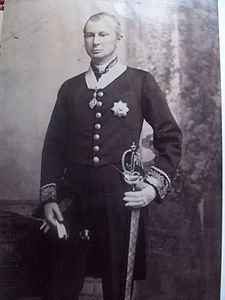Order of the Star of India
The Most Exalted Order of the Star of India is an order of chivalry founded by Queen Victoria in 1861. The Order includes members of three classes:
For other uses, see Star of India (disambiguation).
The Most Exalted Order of the Star of India
1861
Heaven's Light Our Guide
At the monarch's pleasure
Last appointment in 1947
Dormant order since 2009
- Knight Grand Commander (GCSI)
- Knight Commander (KCSI)
- Companion (CSI)
Knight Companion
No appointments have been made since the 1948 New Year Honours, shortly after the Partition of India in 1947. Following the death in 2009 of the last surviving knight, the Maharaja of Alwar, the order became dormant.
The motto of the order was "Heaven's Light Our Guide". The Star of India emblem, the insignia of order and the informal emblem of British India, was also used as the basis of a series of flags to represent the Indian Empire.
The order was the fifth most senior British order of chivalry, following the Order of the Garter, Order of the Thistle, Order of St Patrick and Order of the Bath. It is the senior order of chivalry associated with the British Raj; junior to it is the Most Eminent Order of the Indian Empire, and there is also, for women only, the Imperial Order of the Crown of India.
Members of the Order wore elaborate costumes on important ceremonial occasions:
On certain "collar days" designated by the Sovereign, members attending formal events wore the order's collar over their military uniform, formal day dress, or evening wear. When collars were worn (either on collar days or on formal occasions such as coronations), the badge was suspended from the collar.
At less important occasions, simpler insignia were used:
Unlike the insignia of most other British chivalric orders, the insignia of the Order of the Star of India did not incorporate crosses, as they were deemed unacceptable to the Indian Princes appointed to the Order.




